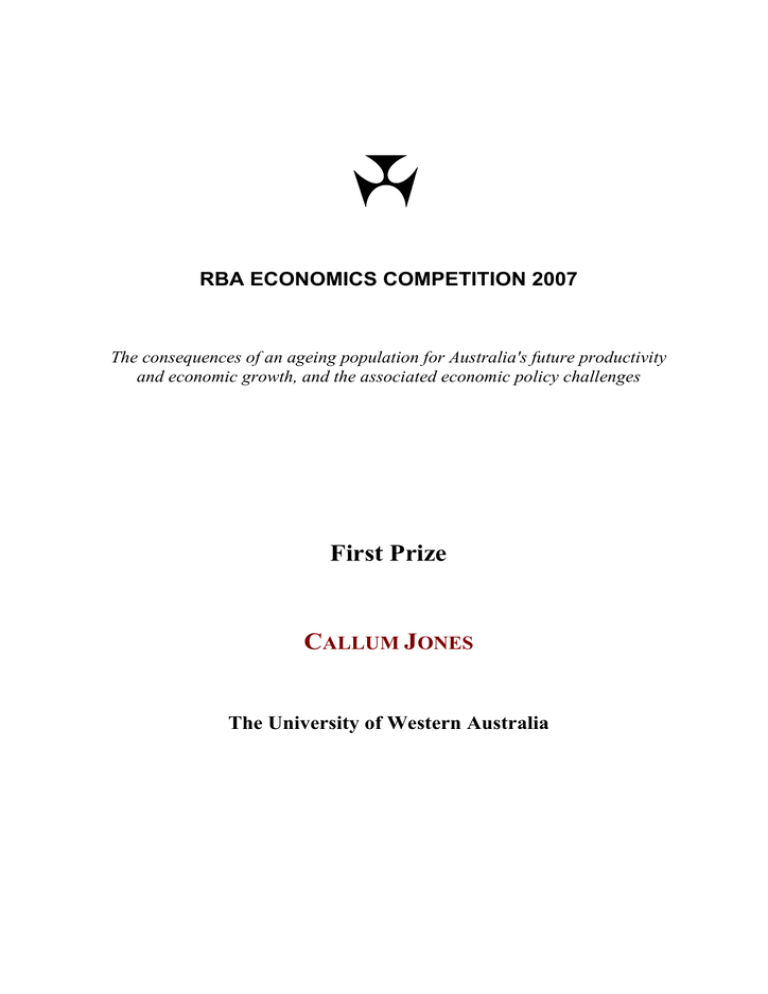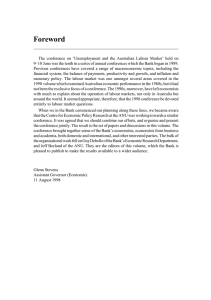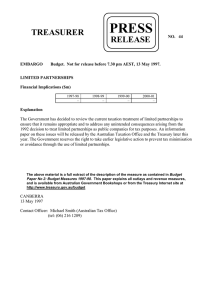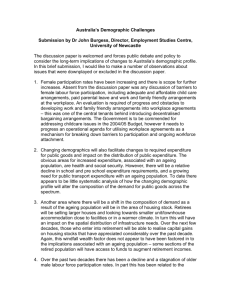RBA ECONOMICS COMPETITION 2007
advertisement

RBA ECONOMICS COMPETITION 2007 The consequences of an ageing population for Australia's future productivity and economic growth, and the associated economic policy challenges First Prize CALLUM JONES The University of Western Australia In the months leading up to the 2006-07 Ashes series in Australia, many commentators suggested Australian pace bowler Glenn McGrath, at 36 years of age, was too old to sustain his outstanding bowling record (Reuters, 2006). Similar comments have been made on the effect of an ageing population on Australian economic performance, that it would not be able to sustain its growth performance as the age distribution of the citizenry shifts upwards. This essay seeks to examine these claims by investigating the consequences of an ageing population on Australian productivity and economic growth, and to analyse the challenges these changes have for economic policy. Demographic Changes Over the coming century, Australia’s population is expected to age for two reasons, a decreasing fertility rate and an increasing life expectancy (Treasury, 2007). Migration will mitigate these influences because, in general, migrants are younger than Australia’s resident population. Projections of the future age distribution of Australia’s citizens are conducted by the Australian Bureau of Statistics (2005) under different demographic scenarios1 and are presented graphically in the Appendix. Figure 1 provides projections under assumptions ‘Series A’, while Figures 2 and 3 provide similar projections under assumptions ‘Series B’ and ‘Series C’. It is clear from projections under all three assumption sets that the age distribution of the Australian population will shift towards the elderly. Metaphorically, and perhaps 1 TABLE 1 ASSUMPTIONS FOR PROJECTION SERIES UNDER CAT. 3222.0 Series A Series B Series C Fertility Rate(b) (babies per person) Net Migration(c) (persons per year) 1.9 1.7 1.5 140 000 110 000 80 000 Life Expectancy at Birth(a) Males Females 92.7 84.9 84.9 95.1 88.0 88.0 (a) From 2050-51 From 2018 (c) From 2007-08 for Series A and Series B, and from 2004-05 for Series B (b) Source: Australian Bureau of Statistics (2005) Cat. No. 3222.0 1 ominously, the age distribution will begin to represent the top-heavy shape of a coffin (Productivity Commission, 2005). The challenge for future economic policy will be to accommodate the anticipated economic effects of these changes. It is these economic effects and the response of policy which this essay seeks to examine. The first important area of effect is the labour market. The Labour Market The effects of ageing will be felt most directly in the labour market. As fertility rates fall, the growth of the working-age population will decline, reducing the supply of labour and restricting the growth potential of the Australian economy. Consider Figure 4 which presents the historical and projected2 growth rate of those of workingage (15 to 64 inclusive). As the red-line indicates, the annual growth of those aged 15 to 64 inclusive fell from about 2% in the 1980s, to 0.8% in 2007 and is projected to further decline to 0.43% in 2021 and 0.15% in 2051. These changes are reflected in a projected increase in the aged-to-working ‘dependency ratio’ as mapped in Figure 5. The ageing effect is also expected to cause the participation rate of those 15 and over to decline from 64.5% in 2005-06 to 57.1% in 2046-47. Figure 6, adopted from the Productivity Commission (2005, p. 85) models the expected impact of ageing on the participation rate illustrating the decline in the relative supply of labour. The decline in the supply of labour will reduce the growth potential of the Australian economy. The Australian economy should expect to see a lower rate of economic growth as the population ages. Figure 7 presents the Productivity Commission’s (2005, p. 127) estimate of the effect of ageing on per capita GDP growth. Accordingly, decomposing growth into changes in population, participation and productivity, with a smaller influence on growth from population (growth of labour supply) and participation, the growth rate of real GDP per person would be primarily a function of the increases in productivity. 2 Assume the mid-range ‘Series B’ assumptions reported by the ABS. 2 Future policy challenges lie in improving the participation, measured or unmeasured (for example, volunteering) of those above retirement age in the labour market to offset the decline in labour supply. A common suggestion is to increase the retirement age. However, this ignores political reality. A more practical approach is to develop a flexible industrial relations system, appropriate aged-care support (‘Hogan Review’, 2004) to enable carers to enter the workforce, and the provision of incentives to induce those older than 65 to work such as conditional health and superannuation benefits. In inducing older citizens to enter the workforce, the challenge is to disprove any notion that participation in the workforce is mutually exclusive to life in retirement. Furthermore, the potential exists for improvements in the participation of women in the workforce which would mitigate some of the decline in the labour supply (Access Economics, 2006). Paradoxically, to address an aged care issue, this could involve improving access to childcare. In addition to the reduction in the growth of labour supply, the age-composition of the labour market will change over time. As illustrated in Figure 8, the proportion of the labour force, separated by decades has converged over time. The net impact of these adjustments on productivity is unclear, primarily because of uncertainty about countervailing influences on productivity levels across age groups. On one hand, older workers have more experience, greater ‘corporate memory’, lower job turnover and lower levels of absenteeism, and paradoxically, sick leave (Access Economics, 2001, p. 14). This is offset by the (historically) lower levels of education of older workers and their declining physical and mental abilities culminating in more accidents (DEWR, 2003). If there is a correlation between age and productivity, we should expect the productivity level of older workers to carry more weight in the overall productivity level. In view of this uncertainty, Treasury (2007) and the Productivity Commission (2005) assume constant productivity growth of 1.75% and conduct sensitivity analyses above and below this level. For predictions of future growth, the significance of productivity should not be underestimated. What may appear to be minor differences in annual productivity growth will affect, significantly, long-run real GDP per capita. For example, the Productivity Commission (2005, p. 140) estimates that a reduction in 3 annual productivity growth of 0.05% across 2003-04 to 2044-45 will cause the Australian economy to be $660 billion cumulatively worse (constant 2002-03 prices). There may be scope for optimism about the size of future labour productivity. First, productivity should rise as citizens have a higher level of exposure to education (Day and Dowrick, 2004, who ‘conservatively’ estimate 2.0% annual productivity growth based on future educational propagation). Second, Gruen and Garbutt (2003) emphasise the application of information and communications technology (ICT) in improving productivity growth through large capital-deepening effects. For example, ICT investment is expected to provide older workers with the capacity to contribute productively by reducing the demands on physiological capacity. Third, Gruen and Garbutt (2003) suggest that labour force growth and productivity growth are strongly negatively correlated; as the labour force growth declines, firms will focus on improving productivity performance to increase output. Policy will play a pivotal role in respect of the preceding analysis. The policy challenge will be to encourage productivity growth. Private ICT investment should be complemented, and perhaps spurred by public infrastructure investment, for example in a comprehensive broadband scheme. To optimise returns from any ICT investment, broad ICT educational projects should be implemented and targeted towards the technologically illiterate. Further, as much as possible should be done to ensure crosscountry transfers in technological improvements. Capital Markets The above section considered projected changes in productivity and growth associated with Australia’s ageing labour market. This section purports to examine the effect of dynamics in capital markets on future growth and productivity performance. Consider the basic Solow Growth Model (Romer, 2006, pp. 9-17). As the labour supply contracts, the level of investment required to maintain capital per unit of effective labour declines. Higher actual investment is sustainable over time and the economy moves to a higher steady-state of capital per worker. By virtue of positive 4 marginal productivity of labour with respect to capital, output per worker – productivity – increases. This is represented diagrammatically in Figure 10. This result, while intuitive, is also simple. The overall dynamics are more complex. Demographic factors affect other variables influencing the level of capital accumulation an economy can sustain. Consider the question whether Australia can sustain the level of savings required to fund the investment required to deepen, or even widen capital investment. The life-cycle savings hypothesis (Modigliani and Brumberg, 1954) suggests that wealth as a function of savings rises up to retirement and then falls as savings are used to finance consumption. As the citizenry age, all else equal, aggregate savings should fall reducing the amount of domestic funds available for capital investment. This raises important questions of policy. Primarily, the challenge is to raise the level of domestic savings and reduce dependence on foreign savings levels with its associated negative effect on the balance of payments. The standard response is to suggest the government sector improve its asset position and reduce expected future spending pressures. This is examined below. A second method is to build personal savings of consumers. Practically, tax cuts should be directed to savings accounts, for example paid into superannuation, rather than into inflationary discretionary incomes (Keating, 2007). It is estimated that if cumulative tax cuts estimated at 6% of income were directed into superannuation, raising the total contribution to 15% of workers’ income, the savings pool available for productive investment would be $300 billion above its present value (Keating, 2007). Additionally, as seen recently under the 2007 changes to superannuation, taxation incentives can be used to increase significantly the attractiveness of saving (Wright, 2007). A further challenge for policy makers is to ensure capital markets are working with maximum efficiency where resources can be applied to areas providing the greatest return on investment, thereby minimising any deadweight loss arising from unnecessary regulatory costs or a lack of perfect information (Treasury, 2007). This is important in responding to anticipated changes in domestic demand. If capital markets are operating efficiently, the level of investment should reflect the future structure of 5 demand with associated improvements in productivity performance in industries such as aged care. Fiscal Pressure As the population ages, public sector expenditure on health, pharmaceuticals and aged care are projected to increase. These expenditure pressures, combined with expected increases in the level of pension transfer payments, constitute a significant challenge for future economic policy (Treasury, 2007). When these changes occur, governments could run fiscal deficits and sustain increasing levels of debt (Figures 11 and 12). This is undesirable as it increases the pressure on sources of savings. Alternatively, governments could increase taxes to make up for the shortfall. However this is particularly unattractive as it will discourage work effort and investment, and therefore productivity and economic growth, as well as amounting to ‘an unconscionable assault on the incomes’ of younger workers (Keating, 2007). A more appropriate response, and the challenge for economic policy, is to improve the sustainability position of the government sector now in preparation for the future. The public sector should continue to build up a net asset position across all levels of government to offset expected increased demands for government funds, and to improve the level of gross national savings. For example, a fund, in the model of the Future Fund could be developed to finance preventative medicines or to prepare for the anticipated increase in the cost of geriatric health, particularly in relation to the Pharmaceutical Benefits Scheme (Treasury, 2007). To complement, and perhaps finance this policy, responsibility for health should be consolidated in the federal level of government which one estimate suggests will result in an overall annual benefit of $14 billion (Australian Associated Press, 2007). These examples, combined with policies designed to improve participation and productivity could improve the sustainability of government finances. 6 Conclusion Inevitably, over time the ageing population will depress the rate of Australia’s economic growth. This is unavoidable; it is Australia’s ‘demographic destiny’ (Peter Costello MP, 2004). Much can be said on the impact of these changes on economic performance. This essay has attempted to give an overview of some of the important issues facing policymakers. The challenge for economic policy will be to accommodate these changes and improve as much as possible Australia’s growth potential through improving participation and productivity, and ensuring markets work as efficiently as possible to adjust to new economic realities. As with the other future issue of climate change, policy should be focussed on sustainability. The key, as Glenn McGrath would point out, is preparation. 7 Appendix FIGURE 1 POPULATION PROJECTIONS UNDER SERIES A ASSUMPTIONS Age (years) 1971 2007 2021 2051 101 101 101 101 91 91 91 91 81 81 81 81 71 71 71 71 61 61 61 61 51 51 51 41 41 41 31 31 31 31 21 21 21 21 11 11 11 11 1 1 1 0 0.5 1 1.5 0 2 0.5 1 1.5 2 51 41 c c 1 0 0.5 1 1.5 2 0 0.5 1 1.5 2 1.5 2 Proportion of Population (percent) FIGURE 2 POPULATION PROJECTIONS UNDER SERIES B ASSUMPTIONS Age (years) 1971 2007 2051 2021 101 101 101 101 91 91 91 91 81 81 81 81 71 71 71 71 61 61 61 61 51 51 51 51 41 41 41 41 31 31 31 31 21 21 21 21 11 11 11 11 1 1 1 0 0.5 1 1.5 2 0 0.5 1 1.5 2 1 0 0.5 1 1.5 2 0 0.5 Proportion of Population (percent) 8 1 FIGURE 3 POPULATION PROJECTIONS UNDER SERIES C ASSUMPTIONS 2007 2021 2051 101 101 101 101 91 91 91 91 81 81 81 81 71 71 71 71 61 61 61 61 51 51 41 41 31 31 31 31 21 21 21 21 11 11 11 11 1 1 1 0 0.5 1 1.5 51 0 2 0.5 51 41 c 1 1.5 2 41 c c 1 0 0.5 1 1.5 2 0 0.5 Proportion of Population (percent) FIGURE 4 Percentage Change of Different Age-Groups 5 4 Percentage Change Age (years) 1971 3 2 1 0 1972 1992 2012 2032 2052 2072 2092 -1 14 and under 15-64 65 and over 9 1 1.5 2 FIGURE 5 Working Age Dependency Ratios 50 Percent 40 30 20 10 1971 1991 2011 2031 14 and under 2051 2071 2091 65 and over FIGURE 6 Source: Reproduced from the Productivity Commission (2005), p. 79. Source: Productivity Commission (2005, p.85) 10 FIGURE 7 Source: Productivity Commission (2005, p. 127) FIGURE 8 Change in Working Age Composition, By Age Group Percent of Working-Age 30 25 20 15 10 1971 1991 15-24 2011 25-34 2031 35-44 45-54 2051 55-64 11 FIGURE 9 Source: Productivity Commission (2005, p. 131) FIGURE 10 y f (k ) ( n1 + g + δ ) k ( n2 + g + δ ) k s. f ( k ) k n1 > n2 12 FIGURE 11 Source: Treasury (2007) FIGURE 12 Source: Treasury (2007) 13 Bibliography Access Economics (2001) Population Ageing and the Economy, Research Report, Canberra Access Economics (2006) Meeting Australia’s Ageing Challenge: The Importance of Women’s Workforce Participation, Report for The House of Representatives Standing Committee on Family and Human Services Australian Associated Press (2004) ‘Costello’s Address in Full’ Sydney Morning Herald, February 25, <http://www.smh.com.au/articles/2004/02/25/1077594870970.html> Australian Associated Press (2007) ‘National Body ‘Should Run Hospitals’’ July 31, <http://news.ninemsn.com.au/article.aspx?id=78280> Australian Bureau of Statistics (2005) Population Projections, Australia 2004 to 2101, Cat. No. 3222.0, Canberra Australian Bureau of Statistics (2006) Population by Age and Sex, Australian States and Territories, Cat. No. 3201.0, Canberra Australian Treasury “Treasury” (2007) Intergenerational Report 2007, Commonwealth of Australia: Canberra Day, C. and Dowrick, S. (2004) ‘Ageing Economics: Human Capital, Productivity and Fertility’, Agenda, 11 (1), pp. 1-20 Department of Employment and Workplace Relations (2003) Submission to the Senate Select Committee on Superannuation: Inquiry into Planning for Retirement (Submission 29), Canberra Gruen, D. and Garbutt, M. (2003) ‘The Output Implications of Higher Labour Force Participation’, Treasury Working Paper 2003-02, October, Canberra 14 Hamada, K. and Kato, H. (2007) Ageing and the Labor Market in Japan: Problems and Policies, Edward Elgar: Cheltenham Hogan, W. (2004) Review of Pricing Arrangements in Residential Aged Care (‘Hogan Review’), Canberra Keating, P. (2007) ‘Put Those Tax Cuts into Super’ The Australian, Monday February 19, 2007 Modigliani, F. and Brumberg, R. (1954) ‘Utility Analysis and the Consumption Function: An Interpretation of Cross-Section Data’ in Kurihara, K. (ed) Post- Keynsian Economics, New Brunswick, New Jersey: Rutgers University Press, pp. 388-436 Onofri, P. (ed) (2004) The Economics of an Ageing Population: Macroeconomic Issues, Edward Elgar: Cheltenham Productivity Commission (2005) Economic Implications of an Ageing Australia, Research Report, Canberra Reuters (2006) ‘I’m in best shape ever, says McGrath’, November 21, <http://www.abc.net.au/sport/content/200611/s1794182.htm> Romer, D. (2006) Advanced Macroeconomics, 3rd ed, McGraw-Hill Irwin Wright, S. (2007) ‘Would-be Retirees Stuff Super Funds With Cash’ The West Australian, 31 August, p. 6 15




